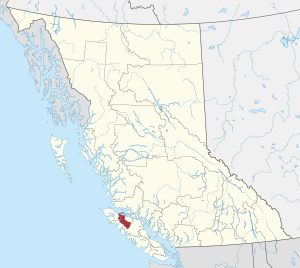ʼNamgis facts for kids
The Namgis are an Indigenous nation, meaning they are one of the original peoples of Canada. They are part of a larger group called the Kwakwaka'wakw. The 'Namgis live in a beautiful area in central British Columbia, on the northern part of Vancouver Island. Their main village is now Yalis, located on Cormorant Island, very close to a town called Alert Bay. Today, the 'Namgis Nation has its own government, known as the Namgis First Nation. In the past, they were sometimes called the Nimpkish.
Contents
Who are the 'Namgis?
The 'Namgis are one of the many First Nations in Canada. They have lived on their traditional lands for thousands of years. Their history is rich with unique traditions, languages, and ways of life. Being part of the Kwakwaka'wakw means they share many cultural practices and a common language family with other nearby nations.
The Kwakwaka'wakw Connection
The Kwakwaka'wakw are a group of Indigenous peoples who live along the northern coast of Vancouver Island and the nearby mainland of British Columbia. The 'Namgis are one of the largest groups within the Kwakwaka'wakw. They share a common language, Kwak'wala, and many cultural traditions, including art, ceremonies, and social structures.
Where do the 'Namgis Live?
The traditional territory of the 'Namgis Nation is located in a stunning part of British Columbia. It includes parts of northern Vancouver Island and the surrounding islands and waters.
Yalis and Cormorant Island
The main village of the 'Namgis is Yalis, which is on Cormorant Island. This island is very close to Alert Bay, a small community that has historically been a hub for many Kwakwaka'wakw nations. The location is important because it allowed the 'Namgis to access rich resources from both the land and the sea.
Natural Resources and Traditional Lands
The 'Namgis traditional lands are full of natural beauty and resources. The forests provided wood for homes, canoes, and tools. The ocean, rivers, and streams were rich with salmon, halibut, and other seafood, which were central to their diet and culture. These resources helped the 'Namgis thrive for centuries.
'Namgis Culture and Traditions
The 'Namgis have a vibrant culture that has been passed down through generations. Their traditions are deeply connected to their land, their history, and their community.
Art and Storytelling
'Namgis art is famous for its detailed carvings, masks, and totem poles. These artworks often tell stories of their ancestors, spirits, and important events. Storytelling is a key part of their culture, used to teach history, values, and lessons to younger generations.
Potlatch Ceremonies
One of the most important traditions is the Potlatch. This is a grand ceremony where a host family or chief gives away gifts to guests. Potlatches celebrate important events like weddings, naming ceremonies, or the raising of a totem pole. They are also a way to show wealth and status, and to confirm social positions within the community. The Potlatch was once forbidden by Canadian law, but the 'Namgis and other First Nations kept their traditions alive, and it is now celebrated openly again.
'Namgis Government Today
The 'Namgis First Nation is the official government of the 'Namgis people. Like many First Nations in Canada, they work to govern their community and protect their rights and culture.
Self-Governance and Community
The 'Namgis First Nation government makes decisions for their community. They manage services like education, housing, and health care. They also work to protect their traditional lands and resources. This self-governance helps the 'Namgis maintain their unique identity and build a strong future for their people.
Protecting Rights and Culture
The 'Namgis First Nation plays a vital role in protecting the rights of their members. They work to preserve their language, Kwak'wala, and ensure their cultural traditions continue to thrive. They also engage with other governments to ensure their voices are heard on important issues that affect their community and territory.
See also



